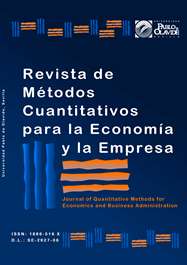Valoración de un seguro de vida mediante opciones exóticas
DOI:
https://doi.org/10.46661/revmetodoscuanteconempresa.4500Palabras clave:
opción exótica, seguro de vida, digital pura, probabilidad de ejercicioResumen
Este trabajo presenta el análisis y valoración de seguros de vida individual, temporarios y con prima nivelada, a partir de la analogía de las reglas del contrato con las de una opción exótica, en particular una digital pura o pulso, también conocida como cash or nothing. Se presentan diversos casos que parten de un asegurado con atributos cambiantes (edad y género) y se testea la sensibilidad a diferentes formas funcionales para la distribución de probabilidad de la variable estocástica, tiempo de vida restante al momento de contratar el seguro, mediante simulaciones de Monte Carlo. En un conjunto de casos la función de probabilidad se ajusta de manera personalizada a datos recientes de la República Argentina para estimar las probabilidades de ejercicio de la opción, variable que resulta sensiblemente crítica para la estimación del valor del contrato. Los valores de mercado de las primas de las pólizas comparables superan en más del doble al valor teórico encontrado para la opción exótica, ante iguales condiciones del contrato en cuanto a monto asegurado, duración y condiciones demográficas del individuo.
Descargas
Citas
Black, F., & Scholes, M. (1973). The pricing of options and corporate liabilities. Journal of Political Economy, 81(3), 637-654. https://doi.org/10.1086/260062
Boletín Oficial de la República Argentina (2018). Legislación y Avisos Oficiales. Superintendencia de Seguros de la Nación. Resolución 697/2018. Recuperado de https://www.boletinoficial.gob.ar/detalleAviso/primera/188883/20180726.
Breslow, N., & Crowley, J. (1974). A Large Sample Study of the Life Table and Product Limit Estimates under Random Censorship. The Annals of Statistics, 2(3), 437-453. https://doi.org/10.1214/aos/1176342705
Casparri, M.T., & García, J. (2010). Algunas innovaciones financieras para La gestión del riesgo global. Buenos Aires: Editorial de la Facultad de Ciencias Económicas de la Universidad de Buenos Aires, Argentina.
Cummins, J.D. (1990). Asset pricing models and insurance ratemaking. ASTIN Bulletin: The Journal of the IAA, 20(2), 125-166. https://doi.org/10.2143/AST.20.2.2005438
Cummins, J.D. (1991). Statistical and financial models of insurance pricing and the insurance firm. The Journal of Risk and Insurance, 58(2), 261-302. https://doi.org/10.2307/253237
D'Arcy, S.P., & Doherty, N.A. (1988). The financial theory of pricing property-liability insurance contracts. SS Huebner Foundation for Insurance Education, Wharton School, University of Pennsylvania. https://doi.org/10.2143/ast.18.2.2014953
del Pozo, E.M. (2001). Modelos de opciones aplicados al seguro (No. 01-09). Madrid: Universidad Complutense de Madrid, Facultad de Ciencias Económicas y Empresariales.
Fernández, P., & Ariño, M.A. (1996). Derivados exóticos. Documento de investigación 308. Centro Internacional de Investigación Financiera (CIIF) y División de Investigación IESE, Universidad de Navarra.
Gaarder, E. (2007). Derivatives: Models on Models. Chichester, United Kingdom: John Wiley & Sons.
García, J.J., Sancha, M.P., Tejero, C., & Toscano, D. (2000). Opciones “exóticas”. Boletín Económico de ICE, 2673, 1-8.
Gatzert, N., & Schmeiser, H. (2006). Implicit options in life insurance: Valuation and risk management. Zeitschrift für die gesamte Versicherungswissenschaft, 95(1), 111-128. https://doi.org/10.1007/BF03353443
Gompertz, B. (1825). On the Nature of the Function Expressive of the Law of Human Mortality, and on a New Mode of Determining the Value of Life Contingencies. Philosophical Transactions of the Royal Society of London, 115, 513-583. https://doi.org/10.1098/rstl.1825.0026
Hull, J. (2012). Options, Futures and other Derivatives (12ª ed.). Harlow, United Kingdom: Pearson Education Global Edition.
Hull, J. (2014). Introducción a los mercados de futuros y opciones (8ª ed.). Madrid, España: Editorial Pearson.
Kolb, R. (2003). Futures, Options, and Swaps. Oxford, United Kingdom: Blackwell Publishing.
Kolb, R., & Overdahl, J. (2010). Financial derivatives. Pricing and risk management. New Jersey, United States: John Wiley & Sons.
Ley Nº 17.418 (1967). Ley de Seguros. Boletín Oficial de la República, Buenos Aires, Argentina, 30 de agosto de 1967.
Luoma, A., Puustelli, A., & Koskinen, L. (2008). Bayesian analysis of participating life insurance contracts with American-style options. In Proceedings of AFIR Colloquium. http://www.actuaries.org/AFIR/Colloquia/Rome2/Koskinen_Luoma_Puustelli.pdf
Makeham, W.M. (1860). On the Law of Mortality and the Construction of Annuity Tables. The Assurance Magazine and Journal of the Institute of Actuaries, 8(6), 301-310. https://doi.org/10.1017/s204616580000126x
Melinsky, Pellegrinelli y Asoc. (2019). Tablas de mortalidad. Recuperado de http://www.melpel.com.ar/?p=678. Fecha de consulta: 01/08/2019.
Merton, R.C. (1973). Theory of rational option pricing. Bell Journal of Economics and Management Science, 4(1), 141-183. https://doi.org/10.2307/3003143
National Vital Statistics Report (2006). United States Life Tables 2003, by Elizabeth Arias. National Vital Statistics Reports, 54(14), 1-40. https://www.cdc.gov/nchs/data/nvsr/nvsr54/nvsr54_14.pdf
Whaley, R. (2006). Derivatives: Markets, Valuation and Risk Management. New Jersey, United States: John Wiley & Sons.
Wilmott, P. (2009). Frequently Asked Questions in Quantitative Finance. London, United Kingdom: John Wiley & Sons.
Yin, R. (2005). Estudo de caso: planejamento e métodos (3ª ed.). Porto Alegre, Brasil: Bookman.
Publicado
Cómo citar
Número
Sección
Licencia

Esta obra está bajo una licencia internacional Creative Commons Atribución-CompartirIgual 4.0.
El envío de un manuscrito a la Revista supone que el trabajo no ha sido publicado anteriormente (excepto en la forma de un abstract o como parte de una tesis), que no está bajo consideración para su publicación en ninguna otra revista o editorial y que, en caso de aceptación, los autores están conforme con la transferencia automática del copyright a la Revista para su publicación y difusión. Los autores retendrán los derechos de autor para usar y compartir su artículo con un uso personal, institucional o con fines docentes; igualmente retiene los derechos de patente, de marca registrada (en caso de que sean aplicables) o derechos morales de autor (incluyendo los datos de investigación).
Los artículos publicados en la Revista están sujetos a la licencia Creative Commons CC-BY-SA de tipo Reconocimiento-CompartirIgual. Se permite el uso comercial de la obra, reconociendo su autoría, y de las posibles obras derivadas, la distribución de las cuales se debe hacer con una licencia igual a la que regula la obra original.
Hasta el volumen 21 se ha estado empleando la versión de licencia CC-BY-SA 3.0 ES y se ha comenzado a usar la versión CC-BY-SA 4.0 desde el volumen 22.










